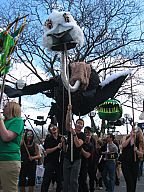View general Festifools photos on Flickr.com, including great shots of Mark and Shoshana's amazing student creations. Click here....
We divide our time between Mark Tucker's festival arts course and Nick Tobier's 150 freshman students in “Art and Society”. Nick organizes his students into “micro-societies” of five or six people each, complete with manifestos and a set of pre-ordained cultural values. Our task was to help them create a “King of Fools” for each society and then present them at Festifools. In various years, we also led workshops with creative writing classes to create a roving performance art en route, including mobile Boca Della Verita that spooled out absurdist narratives from his mouth, which were sliced up into narrative fragments and cast to the bemused spactators. Another year, we taught graduate students at the School of Architecture and Urban Planning to make Tyrolean screen-masks, exploring the influence of ephemeral art on an urban environment.
The seeming Bacchanalian chaos of Carnival belies its reliance on ordered clans, tribes, and societies that have all the complexity, ritual observance, and hierarchy of the ordinary culture they seek to burlesque. The Krewes of New Orleans, the Sailor Bands of Trinidad, and the Peliqueiros of Spain all constitute a “rule of misrule” in which existing hierarchies are not merely cast off, but are meticulously reconstructed according to topsy-turvy principles. Boy Bishops are crowned, paraded on donkeys, and perform backwards masses; pale-faced Devils wear the images of Christian Saints or the spectacles of beaurocrats; and ersatz but fully functional “Black Indian” languages are spoken only during Carnival as chiefs perform sacrifices and chants. These Carnival societies transcend mere buffoonery and base parody by enacting their own ceremonies of inversion, presided over by their own shadow Kings creating, in Mikhail Bakhtin’s words “a second life, a second world “ that “revives and renews.”
The range of Fool’s Kings concocted by the students was impressive. A society espousing solitude and avoidance wore mirrored sunglasses and escorted a lugubrious ostrich. Another celebrated global warming with industrially-inspired head attended by masked and white-suited technicians. Some exploited technological fetishes – (an iPod-toting Jesus) or commercial anxieties (Chinese-made toxic pink bunny toy). Others were fantastical – a tree-born culture festooned with rope bridges or epistemological – a society of duality and anti-duality created twins that were actually opposites. Post-modern dragons, materialistic amoebas, Olmec-inspired Mexican wrestlers, Post-it note encrusted fetish objects, and others added to the already impressive array of puppets brought by our students.
Now as many as five thousand people turn up to watch this inaugural foray into foolishness, which bodes well for the arrival of another much-needed celebration on the festival landscape.







